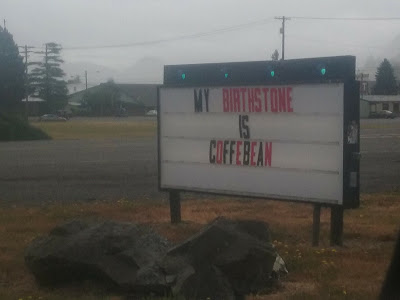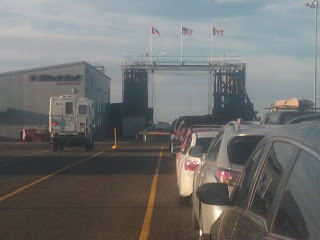Ginny prepared an excellent breakfast for my departure -- unmatched scrambled eggs! George and Small slipped around plotting ways to get up on the table without being noticed.
I was also encouraged to make a sandwich to take along and did so with Blue's careful oversight. Filled once again and inadequately expressing admiration, respect, and gratefulness to my host, I took my leave.
East over the Tacoma Narrows bridge, always recalling the classic film clip of the previous bridge's collapse over a half century ago, and down Interstate 5. Ginny suggested a number of must-see items in the vicinity of Mount Saint Helens, which turned out to be inconveniently located with the remains of a former stratovolcano in between them .... I chose to go for the alpine campground and forest road on the east side, and leave the Ape Cave for another day.
The GPS guided me off the interstate onto narrowing roads that wandered through cloud-obscured peaks. Mount Rainier was up there somewhere, allegedly. I stopped to fuel the Ion and eat the sandwich at Randle before heading up into the forest.

Weather, marginal; view, less so. Likely tenting conditions, wet. Decision -- scratch camping in the clouds, return downhill to the visitor center, half way around the MSH, ask about Ape Cave.
Two more hours of up, down, and around, following the gray strip of road between the tall pines. An impulse detour -- could I get a decent photo of the summit from the Climbers Bivouac? Several uphill miles of dirt road later, I did.
aa
 |
| Mount St Helens crater south rim, up close and personal |
Down off the slopes and back up to the Visitor Center. A friendly ranger on duty encouraged me to visit Ape Cave and then take advantage of "dispersed camping" rules in effect for the National Forest here.
Okay. Off to go spelunking on the longest continuous lava tube in the continental US (Wikipedia) created by another MSH eruption millenia ago. Down to the valley, a few exits worth of Interstate 5, and a long rolling drive up past farms and the trees ....
At 2:40 pm, the cave entrance. It was discovered in 1951 by a logger who avoided driving a bulldozer into a collapsed section. The trail down the 2.5 mile long tube runs 3/4 miles downhill from the entrance for rational visitors -- but the one way distance uphill would be almost the same as the downhill out and back, right? The ranger mentioned something about boulder crawls and lava falls, but did not seem too concerned; I was wearing hiking boots, carrying water and wearing a headlamp. No problem.
The first half mile was strange, beautiful, not at all claustrophobic. The glassy black walls of fused rock formed a high arch above the frozen flat floor of lava that had poured down the tube. Climbing the first pile of boulders was easy, obvious signs of a well used and maintained trail. The second, a little less so, and the third actually took some care to choose my route over the rocks. Not so different than the rockhopping scrambles that my sister and I had enjoyed along Sonoita Creek long ago, with the advantage of having no sun burning down on me.
Then the first lava fall, where the molten rock had frozen as it poured over a ledge about six feet high and smooth except for one foothold that had been hacked into the stone. There was a family of four trying to climb, so I boosted them up, and they pulled me. Standard "O" course approach. The parents thanked me and declined my offer to stay with them the rest of the way, so I went on.
Another two boulder crawls, over open rock rubble. I wondered how many people with sprained ankles have to be evacuated from here? Then, another lava fall to crawl up after spotting three heavy set sisters trying to work their way down. I waited for the family, but they waved off help. Onward, then. feeling the pressure of the lowering ceiling. .
Many boulder crawls followed, some with misleading paths that had me backing down to try a different approach, some that required going through on hands and knees. Three things to bring next time I try something like this: spare batteries, a hiking partner to go for help if I sprain an ankle, and gloves.
Photos -- not much use, really. The flash did reveal mist blowing downhill inside the tunnel, not visible to my eyes.

Up, up, up, boulder crawls getting steeper. How would the family manage, I wondered? The parents seemed confident, the children cheery.
The first skylight! A group of teen guys, clearly gripped with the same almost-panic that I was fighting, was trying to climb out the steep and lichen-covered walls. I excused myself past, reminding them that the ranger had said that the second one was set up as the exit.
On, on, on. The black glass walls closed in, sending me down on hands and knees to crawl under low points. I never cracked my head on the roof, but brushed it two or three times. I could hear the guys who had given up on the first skylight following me.
Finally, the second skylight, with a stepladder. "Found it!" I called back down the tube. Up into the forest, distracting a crowd of students from their teacher's efforts trying to stir interest in his students, Socratic style. They weren't buying it.
Downhill, then, as the shadows deepened over recognizable vents from the tunnel below, chatting with others who had gone through ahead of me. How amazing and strange, I said, something I did not know I had to do before I die, and now I've already done it!
Back at the car, I tried to find the energy to set up a waterless bivouac for the night Desires for wifi to finish planning for tomorrow's travels and for a celebratory dinner won out.
From a sign at the Visitor Center, along a memorial walkway over wetlands created by rockslide dams during the eruption --
As we reflect upon those who died during the eruption, we must respect the unimaginable power of natural forces. Some will only remember the mountains explosive eruption, and others will only remember those who died.
May 18, 1980. Let's remember it all.





















































